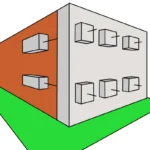Methods for Paver Calculation
Calculating pavers is an essential part of the design and planning process for urban and rural pavements. Whether made of natural stone, brick, or concrete, pavers are paving elements that provide durability and aesthetics to streets, squares, and sidewalks. To achieve an efficient and resilient pavement, it is necessary to properly calculate the quantity of pavers needed, their arrangement, and installation patterns. In this extensive text, we will explore in detail the methods and key considerations for paver calculation, as well as the tools and techniques used in the process.
Introduction to Paver Calculation
Paver calculation is a critical aspect of pavement design, ensuring the use of appropriate materials and achieving a strong and safe surface. Before delving into specific calculation methods, it is important to understand the fundamental concepts that guide this process.
Functions of Pavers in Pavement:
Load Support: Pavers distribute the load evenly, reducing pressure on the underlying soil and preventing deformation.
Drainage: Spaces between pavers allow rainwater to seep into the soil, preventing flooding and pavement erosion.
Stability: Pavers are designed to resist movements and loads, ensuring the pavement maintains its structural integrity.
Aesthetics: In addition to their practical function, pavers also add aesthetic value to paved areas, enhancing the appearance of the urban environment.
Key Factors in Paver Calculation:
Material Type: The type of paver (stone, brick, concrete, etc.) influences its strength and durability, affecting calculations.
Traffic Load: The quantity and type of traffic the pavement will bear are decisive in choosing pavers and their arrangement.
Installation Pattern: How pavers are laid (rectangular pattern, herringbone, etc.) affects the quantity needed.
Area Geometry: The shape and size of the area to be paved determine the quantity of pavers needed.
Soil Resistance: The capacity of the underlying soil to bear the load is a crucial factor in pavement design.

Methods for Paver Calculation
Paver calculation involves determining the necessary quantity of these elements and their optimal arrangement in the pavement. Various methods and approaches are used by engineers and urban planners to carry out this process. Below, we will describe these methods and provide a detailed understanding of each.
Total Area Method
The Total Area Method is a paver calculation technique mainly used when the surface to be paved is rectangular or square and has a uniform arrangement of pavers. This approach is based on a fairly simple premise: the quantity of pavers needed is directly proportional to the total area to be covered. Here, we will delve into the details of this method:
Steps for the Total Area Method:
Area Measurement: The first step is to accurately measure the total area to be paved. This involves taking the dimensions of the terrain, i.e., the length and width of the area in square meters (m²). These measurements should be as precise as possible.
Paver Type Selection: The type of paver to be used in the project must be chosen. Each type of paver will have specific standard dimensions, such as length, width, and thickness. Knowing these dimensions is crucial, as they will be essential in the calculation.
Quantity Calculation: Once the total area has been measured, and the size of the paver is known, proceed to calculate the required quantity of pavers. The basic formula for this calculation is:
Paver Quantity = Total Area / Area Occupied by a Single Paver
Total Area: The surface to be paved, expressed in square meters (m²).
Area Occupied by a Single Paver: This is calculated by multiplying the length and width of the paver (in meters) to obtain its area in square meters (m²).
For example, if a type of paver measuring 10 cm x 10 cm (0.1 m x 0.1 m) is used, the area occupied by a single paver would be 0.01 m² (0.1 m x 0.1 m). If the total area to be paved is 100 m², then 10,000 pavers would be needed (100 m² / 0.01 m²/paver).
Advantages of the Total Area Method:
Simplicity: This method is easy to understand and apply, making it suitable for projects with simple geometric shapes.
Speed: The calculation is quick and efficient, which can be useful in smaller projects with tight deadlines.
Uniformity: It works well when a uniform arrangement of pavers is required, such as in rectangular sidewalks or paths.
Limitations of the Total Area Method:
Not Suitable for Irregular Shapes: It is unsuitable for areas with irregular shapes or complex installation patterns, as it does not account for these factors.
Does Not Consider Wastage: It does not account for material losses due to cutting pavers to fit edges or corners, which may result in the purchase of more pavers than necessary.
Does Not Consider Diagonal Patterns: It is not suitable for projects with diagonal installation patterns or other non-rectangular arrangements.
Hering's Formula Method
Hering’s Formula Method is a more precise approach to paver calculation compared to the Total Area Method. It is used when the arrangement of pavers follows a herringbone pattern or any other diagonal pattern. This method takes into account both the length of the pavers and the quantity of pavers needed to cover a unit area in the installation pattern. Below, we will delve into the details of this method:
Steps for Hering's Formula Method:
Area Measurement: Similar to the Total Area Method, the first step involves accurately measuring the total area to be paved in square meters (m²).
Paver Type Selection: Just like in the Total Area Method, the type of paver to be used in the project must be chosen, and its standard dimensions, including length (L) and width (A), must be known.
Paver Quantity Calculation: To calculate the quantity of pavers needed, Hering’s Formula is used:
Paver Quantity = Total Area / Area Occupied by a Paver in the Installation Pattern
Area Occupied by a Paver in the Installation Pattern: This area is calculated taking into account the length (L) and width (A) of the paver, as well as the angle (θ) between the pavers in the installation pattern. The formula is as follows:
Area Occupied by a Paver = (L x A) / (cos θ)
Angle (θ): The angle between the pavers in the installation pattern is a critical factor in this formula. It must be measured accurately or calculated if the pattern is known.
Advantages of Hering's Formula Method:
Precision: This method is more precise than the Total Area Method, as it considers the specific arrangement of pavers in diagonal or oblique patterns.
Suitable for Diagonal Patterns: It is especially useful in projects with herringbone, chevron, or any diagonal installation patterns, as it can adapt to these patterns accurately.
Reduced Wastage: By considering the arrangement of pavers at an angle, this method can help reduce wastage by more accurately calculating the necessary quantity.
Limitations of Hering's Formula Method:
Higher Complexity: It requires a more detailed calculation and precise measurement of the angle between pavers, making it more complex than the Total Area Method.
Not Suitable for Rectangular Patterns: It may not be the best choice for projects with rectangular or square installation patterns, as its precision may not provide significant advantages in such cases.

Additional Considerations in Paver Calculation
While the Total Area Method and Hering’s Formula Method are two common approaches to paver calculation, there are additional considerations and factors that engineers and planners should take into account for a comprehensive and accurate calculation.
Wastage: When calculating pavers, it is essential to consider potential wastage due to cutting pavers to fit edges, corners, or irregular shapes. A common practice is to add a percentage (e.g., 5-10%) to the calculated quantity to account for wastage.
Edge and Corner Pavers: In projects with non-rectangular shapes, the need for specially cut edge and corner pavers should be considered. These are pavers that are cut to fit the specific geometry of the paved area.
Border Pavers: Some projects may require border pavers along the edges to provide stability and a finished appearance. The quantity of border pavers should be calculated separately from the main field of pavers.
Patterns and Arrangements: The chosen installation pattern or arrangement of pavers can significantly impact the quantity needed. Certain patterns, such as herringbone or basket weave, may require more pavers than simpler patterns.
Site-Specific Factors: Site-specific factors, such as soil conditions, climate, and maintenance requirements, should be considered in the overall pavement design. These factors may influence the selection of pavers and the overall design approach.
Professional Software Tools for Paver Calculation
While manual methods are valuable for small projects or initial estimations, professional software tools can streamline the paver calculation process for larger and more complex projects. These tools often incorporate advanced algorithms, 3D modeling, and optimization features to provide accurate and efficient results. Some popular software tools for paver calculation in civil engineering and urban planning include:
AutoCAD: AutoCAD is a widely used computer-aided design (CAD) software that offers tools for creating detailed drawings and designs, including those for pavements. It allows engineers to input dimensions, patterns, and other parameters to calculate paver quantities accurately.
Revit: Revit is a building information modeling (BIM) software that enables architects and engineers to design, simulate, and analyze structures in a 3D environment. It includes features for pavement design and calculation, taking into account various factors.
InfraWorks: Autodesk InfraWorks is a comprehensive infrastructure design software that allows users to create, visualize, and analyze infrastructure models. It includes tools for pavement design and analysis, helping engineers optimize material quantities and project costs.
Civil 3D: AutoCAD Civil 3D is a civil engineering design and documentation software that supports BIM workflows. It includes features for designing and analyzing pavement surfaces, considering factors such as slope, drainage, and material quantities.
Pavement Design Software: There are specialized pavement design software tools that focus specifically on calculating material quantities, including pavers. These tools often include databases of paver types, patterns, and installation specifications.
Conclusion
Accurate paver calculation is a crucial step in the design and construction of durable and aesthetically pleasing pavements. The choice of calculation method depends on various factors, including the shape of the paved area, the type of pavers, and the installation pattern. The Total Area Method is a straightforward approach suitable for projects with uniform and rectangular patterns, while Hering’s Formula Method offers greater precision for projects with diagonal or herringbone patterns. Engineers and planners should also consider factors such as wastage, edge pavers, and border pavers to ensure a comprehensive and reliable calculation. Additionally, the use of professional software tools can enhance efficiency and accuracy in paver calculation, especially for larger and more complex projects. By carefully considering these factors and employing appropriate methods, civil engineers and urban planners can contribute to the creation of robust and visually appealing pavements in both urban and rural settings.







Related
Gravity Retaining Walls
What are Anchored Retaining Walls?
All About Reinforced Concrete – Construction